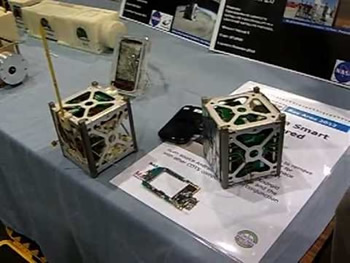HTC's Nexus One is about to make its own giant leap into the inky blackness of space, courtesy of NASA. The iconic agency aims to make headway in its Small Spacecraft Technology Program by determining if inexpensive consumer hardware can dependably survive harrowing journeys through space.
So, exactly why is sending a smartphone beyond our blue fish bowl important to NASA? The agency believes rocketing pint-sized satellites into space will set the foundation for a low-cost payload delivery system. NASA eggheads hope to also improve upon or evolve new propulsion techniques by working with smaller devices.
The first wave of these smartphone-powered satellites will be housed in a modular, cube-based chassis coined as a CubeSat. The dimensions of the first PhoneSat will span just 10x10x10 centimeters – that's about twice the size of a Rubik's Cube. The shell will contain a Nexus One smartphone, an external battery, radio equipment and a watchdog circuit which be will be used to reboot the device in case the necessity arises.
If you own a Nexus One, take a moment to feel proud: the smartphone successfully completed NASA's stress tests without any modifications. Those simulations ensure the Nexus One will be able to withstand the rigors of launch and orbit.
Somewhat amusingly, the PhoneSat's miniscule, four-pound self will be delicately nestled upon an Antares rocket during launch – a 15,000-pound, 133-foot behemoth charged with the responsibility of delivering the tiny device beyond the out layers of atmosphere. From high above us, PhoneSat 1.0 will orbit for a bit, sending sensor data and photographs back to mission control.
After the launch of PhoneSat 1.0, a more advanced successor is planned. PhoneSat 2.0 will be upgraded to a Nexus S and contain more sophisticated hardware, including solar panel arrays and a two-way microwave radio.
These prototype PhoneSat units will cost NASA just $3500 each. However, catapulting the satellite into LEO on the back of an Antares rocket should still cost many millions of dollars. After all, defying the Earth's gravitational pull is no trivial feat.
